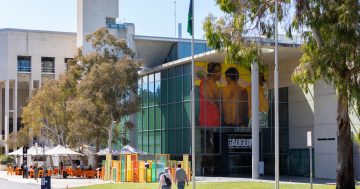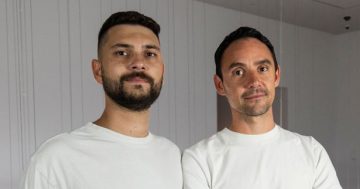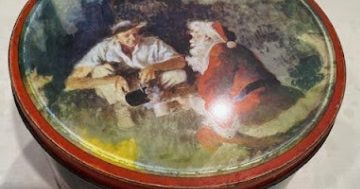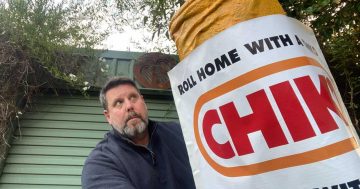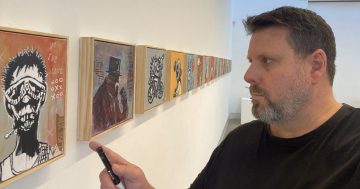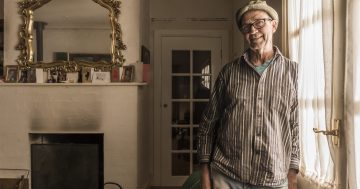
Cornel Swen at the Belconnen Arts Centre. Photo: Canberra Potters Society Facebook.
Well-respected Queanbeyan graphic artist and designer Cornelius ‘Cornel’ Swen has passed away at the age of 91.
Born in 1930 in Randstad-Rotterdam, The Netherlands, he moved to Australia in 1951 where he worked as a freelance artist in Sydney.
His first employer was K G Murray Publishing in 1952, where he learned to create designs within tight production deadlines.
He eventually bought a block on Sydney’s North Shore and asked his parents and older brother to come and live with him under the one roof after his home was built.
Cornel became an Australian citizen in 1961 before travelling to south-east Asia to work in advertising in Singapore.
On this trip in 1965, he made a journey to Japan and met his future wife, prolific ceramic artist Hiroe Swen, through a mutual friend who had been acting as Cornel’s unofficial guide in the country.
In her 2013 biography of her husband Cornel’s Eurasian Art Trail, Hiroe described their meeting in Kyoto: “‘Hiroe-san, kochira-wa Cornel-san desu…’ with this introduction by a former pottery student of mine I came face-to-face with a tall, lanky Australian,” it read.
“Gradually Cornel became a fixture at the small restaurant I ran in the evenings.
“With hindsight it seems obvious the euphoria my Australian customer was experiencing would, inevitably, lead to some romance …”
They dated for six months before Cornel proposed via letter.
They became engaged the next day and decided to stay in Japan for two years to allow Hiroe’s parents to get to know him better.
Cornel’s support allowed Hiroe to close her restaurant to focus full-time on being an artist and she created works for two solo shows that helped launch her career when they left Japan.
The pair returned to Australia in 1968, eventually buying a 22-ha sheep farm on the outskirts of Canberra.
The Swens set up the Pastoral Gallery in Queanbeyan in 1973 (which they ran until 2003), while Hiroe became an Australian citizen shortly afterwards.
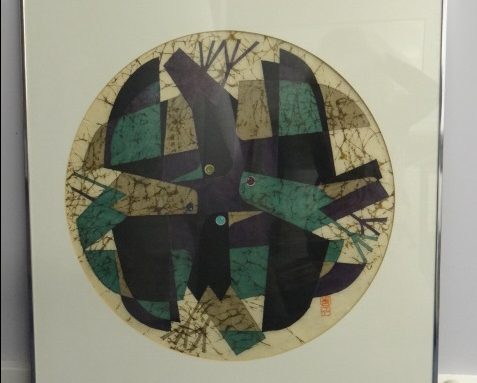
Currawongs at Kosciusko by Cornel Swen. Photo: University of Canberra.
During this time Cornel began presenting his dye paintings on washi paper and rekindled his interest in contemporary batik painting, works that he is generally known for today.
“Native Australian wildlife became a recurring theme in all his paintings,” Hiroe said in her book.
“His background in graphic design, coupled with his European roots, automatically gave his depictions of our fauna a very personal slant.
“Initially circular in format, his later paintings returned to more common shapes.”
Cornel spent 13 years using the technique before the toxicity of the dyes began to impact his health and he stopped using them in 1994.
Both Cornel and Hiroe were heavily involved in Canberra and the surrounding region’s art scene. The Queanbeyan City Council commissioned the pair in 2004 to design an outdoor monument to commemorate the town’s relationship with Southern Alps City in Japan.
Hiroe described it: “The silhouette of an enlarged kimono-like garment, decorated with six stainless steel discs, each bearing an image of an iconic Australian animal, took two years to reach its unveiling…”
It was erected in Sister City Park on Macquoid Street in Queanbeyan.
Hiroe Swen was made a life member of the Canberra Potters’ Society in 2018.
The Canberra Potters’ Society CEO Richard Thomas said he was “deeply saddened” to hear of Cornel’s passing.
“Our thoughts are with Hiroe at this time,” he said.







